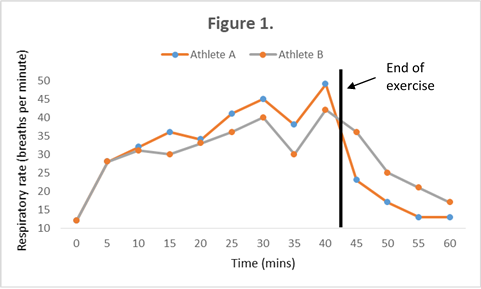Note that your final mark will not be saved in the system.
1.1.e. Effects of exercise on body systems GapFill
You must fill all the gaps before clicking ‘Check Answers!’

Figure 1. shows the respiratory rate of two athletes during and after a basketball game.
The respiratory rate increases at the onset of exercise; this means that both athletes are taking more breaths per in order to meet the demands of the lungs and delivery to the working muscle for the players to maintain running for the duration of the game. The difference between the respiratory traces of athlete A and athlete B during exercise can reflect both the work rate and the training status of the individual. For example, athlete A may be than athlete B, thus covering more distance around the court and increasing the team's chances of winning. This is because a long-term effect of exercise is an increase in the of respiratory muscles, namely the and muscles. The result of this is an overall increase in the amount of air inspired per minute, i.e. a greater minute . Equally, another reason why athlete A has a greater respiratory rate than athlete B might be due to a higher work rate or a more active playing position which requires both defensive and offensive duties.
Following exercise, athlete A has a consistently respiratory rate than athlete B. This evidences athlete A's rate of following exercise.